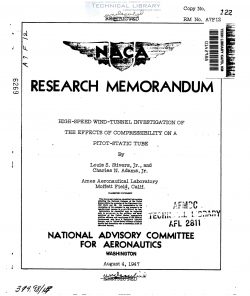naca-rm-a7f12
- Version
- 126 Downloads
- 687.15 KB File Size
- 1 File Count
- March 14, 2017 Create Date
- March 14, 2017 Last Updated
National Advisory Committee for Aeronautcs, Research Memorandum - High Speed Wind Tunnel Investigation of the Effects of Compressibility on a Pitot-Static Tube

A high-speed wind tunnel investigation has-been made of a
pitot-static tube having the Federal Standard Stock Catalog
No. 88—1L295O to provide information on the effects of compressi—
bility upon the pressure indications of a representative airspeed
head at high subsOnic speeds. The calibration factor for the
instrument has been evaluated for several small angles of pitch and
yaw throughout a Mach number range from 0.30 to approximately 0.925.
The results indicate that the calibration factor for each
combination of pitch and yaw angles tested is, in most cases
practically constant with Mach number up to a Mach number of
approximately 0.8. A greater variation in the calibration factor
exists for changes in yaw angle than for changes in pitch angle,
and Only slightly more variation for changes in positive pitch
angle than for changes in negative pitch angle. At zero pitch and
zero yaw the error in the differences of the total and static
pressures given by the pitot—static tube is never greater than
1.6 percent for speeds up to a Mach number of 0.925.
The need for additional information c0ncerning the practica-
bility of pitot—static tubes for indicating airspeeds near the speed
of sound becomes increasingly apparent as the operating speeds of
aircraft approach this velocity more and more closely. Windytunnel
investigations of several standard service pitot—static tubes at
speeds up to approximately 0. 8 Mach number have been reported in
references 1 end'E. I Each pitot-static tube was tested. at zero
pitch and. zero yaw; one pitot-static tube of reference 2 was also
tested. at small angles of pitch.
To supplement the existing information on this subject, the
present investigation was undertaken in the Ames l- by 3—1/2—foot
high—speed. wind tunnel to evaluate the effects of compressibility
on the velocity indications of a. high-speed—ftype service pitot— "
static tube at speeds up to approximately 0. 925 Mach number. The
tests were extended to include several small angles of pitch and.
yaw.
| File | Action |
|---|---|
| naca-rm-a7f12 High Speed Wind Tunnel Investigation of the Effects of Compressibility on a Pitot-Static Tube.pdf | Download |

Comment On This Post